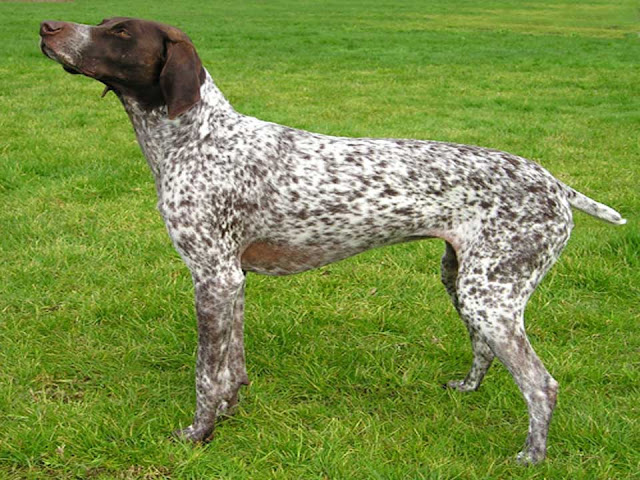German Shorthaired Pointer is a medium-to-large sized dog breed originally developed in Germany in the 19th century for the purpose of hunting. German Shorthaired Pointer is a multipurpose hunting or gun dog breed suitable for both land and water. Being powerful and strong legs make the dog able to move quickly and turn rapidly.
Appearance
German Shorthaired Pointer has abstemiously long limp ears set high on the head. Its muzzle is long, broad, and strong, letting the dog retrieve even heavy game. The dog's profile should be straight or intensely Roman-nosed; any dipped appearance to the profile is incorrect. The eyes are normally brown, with darker eyes being desirable; yellow or ‘bird of prey’ eyes are a fault. The tail is usually docked, but in some countries, it is prohibited. In present breed, the tail is docked at about 40% of length before it curves. In competition shows, the dog is penalized if the tail is curved either up or down while the dog is walking. When German Shorthaired Pointer is in a standing posture, the tail should be held straight out from the body, making a line with the pointing head and body. Like all German pointers, German Shorthaired Pointer has webbed feet for going after waterfowl in the water.
Coat and color
German Shorthaired Pointer has a short and flat coat with solid basecoat protected by stiff guard hairs making the coat water-resistant and letting the dog stay warm in cold weather. This makes the dog an agile hunter to perform well in both field and water. The color must be dark brown (referred to as ‘liver’) but incorrectly as ‘Chocolate’ or ‘Chestnut’), black roan, liver roan, white, liver and white, or black and white. The AKC (American Kennel Club) identifies only a solid liver or liver and white coat. Usually, the head is a solid or closely solid color, and the body is freckled or marked with liver and white, occasionally with large patches of solid color named ‘saddles’. The roan coat is also prevalent with or without patching, however, solid liver and solid black coats also occur sometimes with a small blaze of marking or white on the chest. The coloring of German Shorthaired Pointer provides camouflage in cold weather. The coat is very silky if washed.
Temperament
The German Shorthaired Pointer was decisively bred to be suitable for family, as well as a multipurpose hunter. So its temperament is that of an intelligent, daring, odd, energetic, and typically affectionate dog that is cooperative and easily trained. The German Shorthaired Pointer is a smart, friendly, willing, and enthusiastic dog breed. The dog is generally good with children but care should be taken because the dogs can be boisterous mostly when they are young. These dogs love the interaction with humans and are suitable pets for active families who will give them an outlet for their substantial energy; they must be avidly run several times in a week.
The breed should be socialized, which comprises interaction with different people, sights, sounds, and experiences when they are young. This early socializing will help to realize that your German Shorthaired Pointer Puppy will grow up to be a comprehensive dog. So a regular training would be essential through a training class. Most German Shorthaired Pointers make excellent watchdogs. The breed usually gets along well with other dogs, though females appear to be much more dominant during interbreed interaction. A robust hunting nature is correct for the breed, which is not always good for other small pets such as cats or rabbits.
Training and Exercise
German Shorthaired Pointer desires sufficient energetic activity and thrives with many exercises and running. The dog is athletic and can escape from 4 to 6 feet enclosures with little difficulty. Failure by the owner to give this eager and intelligent dog an adequate training or exercise can produce abnormality and negative trends in German Shorthaired Pointer. So this breed is not suitable for inactive homes or inexpert owners. Although these dogs make very strong connections with their owners.
Current Uses
German Shorthaired Pointer is now used as multipurpose hunting and gun dog. With extraordinary intelligence and athleticism, German Shorthaired Pointer performs well in several AKC sports, for example, Agility, Dock Diving, Obedience along with Service Dog work.
History
The exact origin of German Shorthaired Pointer is indistinct. According to AKC, it is likely that the German Shorthaired Pointer is derived from a breed known as ‘German Bird Dog’ which itself is related to the Old Spanish Pointer introduced to Germany in the 17th century. It is also likely that various German hounds and tracking dogs, as well as the English Pointer and Arkwright Pointer also contributed to the development of this breed. However, the first Studbook of this breed was not made until 1870, so it is very difficult to recognize all of the dogs that went into creating this breed. The breed was formally documented by the American Kennel Club (AKC) in 1930.





